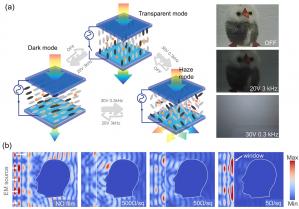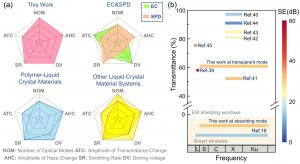Multispectral Smart Window: A Step Towards Healthier Indoor Environments
USA, September 3, 2024 /EINPresswire.com/ -- A new multispectral smart window has been developed, capable of adjusting light transmission and providing robust microwave shielding. Combining liquid crystal scattering with dye doping, this technology allows independent control of transmittance and scattering in a single layer. Operating effectively at low frequencies, it enhances electromagnetic shielding without losing transparency. This breakthrough offers exciting possibilities for energy-efficient and communication-enhancing architectural applications.
Windows, the vital conduits between indoor spaces and the external environment, also serve as primary entry points for harmful light waves and electromagnetic (EM) waves. However, managing light transmission and scattering typically requires different material systems and devices. Additionally, a critical aspect often overlooked in smart window technology is EM modulation. Therefore, windows capable of visible light regulation and EM shielding are becoming an urgent necessity.
In a new paper (doi: https://doi.org/10.1038/s41377-024-01541-y) published in Light: Science & Applications, a team of scientists led by Professor Jiaqi Zhu from Infrared Films and Crystal presents groundbreaking research titled "Multispectral Smart Window: Dynamic Light Modulation and Electromagnetic Microwave Shielding". The study introduces an innovative multispectral smart window capable of regulating visible light while simultaneously blocking microwave signals. The structure of this window includes a core liquid crystal mixture composed of negative liquid crystals, ionic surfactants, and dichroic dyes, followed by vertically aligned polyimide layers and indium tin oxide (ITO) film, all encapsulated within a glass substrate.
As shown in Figure 1(a), combining dynamic scattering and liquid crystal doping achieves precise control over transmittance and scattering, ensuring better energy savings and privacy protection. Furthermore, optimizing the ITO film thickness provided effective microwave shielding without sacrificing optical performance, reducing potential health risks brought about by the rise of 5G networks, as shown in Figure 1(b).
Comparing existing electronically controlled smart windows and transparent structures for microwave shielding technologies, this study demonstrates significant advantages in five dimensions: response time, transmittance adjustment range, haze adjustment range, driving voltage, and optical modulation mode, as shown in Figure 2(a). As shown in Figure 2(b), compared to existing transparent electromagnetic shielding materials, this study exhibits superior performance across the covered shielding bands, including S, C, X, and Ku bands. Moreover, the electromagnetic shielding effect of this approach significantly surpasses that of commercially available PDLC materials.
In summary, this study presents a novel multispectral smart window technology designed to mitigate electromagnetic pollution while dynamically adjusting incoming sunlight through transitions between transparent, absorbing, and haze states. With the help of the proposed ion movement model and dielectric constant operation strategy, the ratio of CTAB and SDS was determined to achieve a lower optimal driving frequency (~300Hz), thereby avoiding electrical breakdown that is more likely to occur under high-frequency driving. Additionally, by optimizing the thickness of the transparent conductive film, the broadband electromagnetic shielding effect was significantly improved to 30.9dB, while minimizing the impact on optical transparency. This research provides a beneficial attempt at coordinating the design and optimization of smart windows for both solar spectrum and microwave spectrum management.
DOI
10.1038/s41377-024-01541-y
Original Source URL
https://doi.org/10.1038/s41377-024-01541-y
Funding information
Ruicong Zhang, Zicheng Song contributed equally to this work. This work thanks the financial supports from the National Key Research and Development Program of China (Grant No. 2023YFB3811600), the National Science Fund for Distinguished Young Scholars (Grant No. 51625201), State Key Program of National Natural Science of China (Grant No. 52032004), National Youth Science Funds of China (Grant No. 52102039), Key Research and Development Program of Heilongjiang Province (Grant No. GA21D001,2022ZX06C05),the Fundamental Research Funds for the Central Universities(Grant No. HIT.OCEF.2022011), the Major Program of Harbin Institute of Technology (Grant NO. 2023FRFK01002),the Fundamental Research Funds for the Central Universities (2022FRFK060026) and the National Youth Science Funds of China (Grant No. 52302172).
Lucy Wang
BioDesign Research
email us here
Legal Disclaimer:
EIN Presswire provides this news content "as is" without warranty of any kind. We do not accept any responsibility or liability for the accuracy, content, images, videos, licenses, completeness, legality, or reliability of the information contained in this article. If you have any complaints or copyright issues related to this article, kindly contact the author above.


